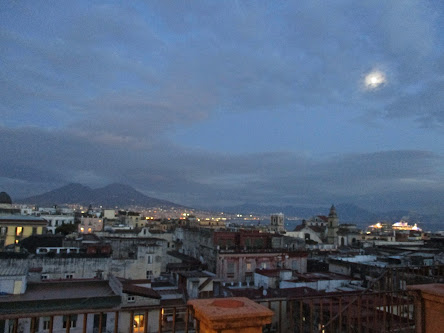 |
| ©Nigel Summerley |
When I saw this reproduction head in an antiques shop window in Naples, it was like meeting an old friend.
 |
| ©Nigel Summerley |
When I saw this reproduction head in an antiques shop window in Naples, it was like meeting an old friend.
 |
| ©Nigel Summerley |
 |
| ©Nigel Summerley |
The worst job you ever had is probably nowhere near as bad as that of those who once laboured in the Neapolitan catacombs of San Gaudioso in the 17th century.
God knows how, but the monks who ran the place came up with a novel way of preserving the well-off dead for posterity – and making some extra money in the process.
Down beneath the church of the Basilica Santa Maria della Sanita in Naples, I was shown the stone benches where the corpses of the rich used to be sat against the wall and then (with buckets placed beneath them) punctured to drain off all their fluids.
This process took a while apparently, so the body drainers, the schiattamuorti, sometimes had quite a few customers sitting in a row, waiting to be fully desiccated.
It must have been like working in some sort of a cross between a care home and Hell.
There was no fresh air coming into the catacombs – apart from when trap doors above were opened to lower a new corpse into place. The lack of ventilation combined with the noxious effects of exposure to decomposing bodies meant the lives of the schiattamuorti were constantly at risk.
When one of the dead was thoroughly dried out, the body was buried, but what remained of its precious head was stuck in the walls of the catacombs; and then a bizarre portrait of a skeleton wearing the clothes of the deceased was painted beneath it.
This ritual continued for several decades before someone noted how unhygienic – not to mention slightly unhinged – it was and the practice was brought to an end.
All the bones were eventually removed from the catacombs along with the front halves of the skulls on display. As you'll see from these pictures, the remains of the skulls – and the accompanying frescoes – are still very much visitable and visible.
The Catacombs of San Gaudioso present a weirdly wonderful cocktail of life, death and superstition... just like Naples itself.
 |
| ©Nigel Summerley |
 |
| ©Nigel Summerley |
 |
| San Gennaro Catacombs ©Nigel Summerley |
I've already touched on some of the history of the unfortunate San Gennaro [see this blog 26 December 2021, See Naples and Live – 20: Bones and Blood] who had his head removed by the Romans in Pozzuoli near Naples in the 4th century because he was a fervent Christian.
His body and his head – and allegedly his blood – all travelled around quite a bit. But in the 5th century most of his remains were brought to Naples and buried in the catacombs that today still bear his name.
Four centuries later those remains were stolen and removed to the town of Benevento which also had a claim on the poor man.
In 1497 the saint's bones were finally returned to Naples – where some of them can still be seen in the Cathedral.
But more atmospheric by far are those Catacombs of San Gennaro – in the Sanita district – where not only he but many of the early Christians were entombed while they waited for their expected resurrection.
The Catacombs are a long way out from the centre of the city and not brilliantly signposted – in fact, not really signposted at all. But don't be put off. The locals are used to confused visitors wandering about and they happily dispense directions, often without being asked. Sometimes they just smile and point...
The remains of Gennaro are no longer here, of course, but you can see the tomb where he was once laid – and the many niches in which his fellow Christians were sealed up – and marvel at this underground cemetery whose structure also served as an atmospheric church.
Some of the intensity of the lives of these followers of Jesus can be picked up from exploring this subterranean sepulchre – but it is nothing to the eerie nature of the Catacombs of San Gaudioso, also in Sanita and also to be featured shortly in this blog.
 |
| San Gennaro Catacombs ©Nigel Summerley |